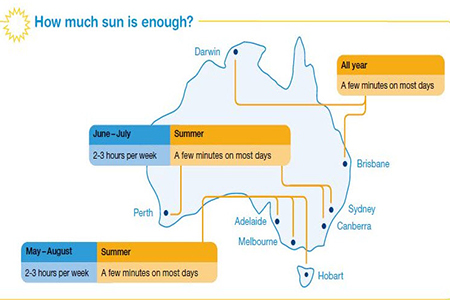Vitamin D is essential for strong bones, muscle and general healthy wellbeing. The best source of vitamin D is the sun’s ultraviolet (UV) radiation, but unfortunately UV radiation is also the leading cause of skin cancer. The trick to managing this is to take a balanced and careful approach to sunlight exposure.
For most people, adequate vitamin D levels are achieved through regular daily activity. In a country such as Australia, where the levels of UV radiation are high, incidental exposure to the sun is usually enough to ensure you are getting a healthy dosage of vitamin D. In summer, it may just even take a few minutes to get the results your body needs.
And it’s not always necessary to deliberately seek out the sun to acquire vitamin D, so there’s no reason why you would need to lay directly in the sun for exposure. Depending on where you live, you could just need an hour or two in the sun over a course of a week, which more often than not you build up simply by running errands outdoors.
However, if you spend most of your time indoors and make little or no effort to get sun to your face, arms and hands, you could run the risk of becoming vitamin D deficient.

How much sun is enough?
How much sunlight each individual requires is very subjective, and will be dependent on your skin type, the UV level each day and your lifestyle. How much of your skin is exposed to the sun at any time will also have an impact.
The Cancer Council Australia recommends that short periods in the sun – such as walking from your office to the café where you get lunch – is a safer way of satisfying your vitamin D needs than prolonged exposure such as hours of sunbathing.
They have stated that in summer, people residing in the southern coastal regions of Australia (including Perth, Hobart, Adelaide, Canberra, Melbourne and Sydney) require only a few minutes of sunlight a day to receive a sufficient amount of vitamin D. They also said that for those in the northern regions of Australia (such as Darwin and Brisbane) only a few minutes per day is needed regardless of the season.
However, it is advised that people with skin that is naturally very dark will likely need between 3-6 times the amount of sun that is required by those with fairer skin.
It is almost important to note that anyone taking prescription medications that may cause a sun-sensitivity, such as photoallergies or phototoxicity, should consult with their GP about a course of action regarding supplemental vitamin D.
What is vitamin D deficiency?
A vitamin D deficiency is the term used when a person has abnormally low levels of vitamin D in their body. A deficiency doesn’t always present symptoms, but leaving a vitamin D deficiency untreated can have significant health effects.
Vitamin D is a hormone that controls calcium levels in the blood. When levels of the hormone are too low, a person runs the risk of developing musculoskeletal conditions such as bone and muscle pain, rickets and osteopenia.
Rickets: Rickets is a preventable bone disease that affects infants and young children. Due to a lack of vitamin D, a child’s growing bones fail to develop properly, resulting in soft, weakened bones, fractures, and bone and muscle pain, and bone deformities.
Osteopenia: Osteopenia refers to bone density that is lower than normal peak density but not low enough to be classified as osteoporosis. As you grow older, your bones naturally thin and with osteopenia bones become fragile and weak.
As well as musculoskeletal conditions, vitamin D deficiency has been linked with:
- Multiple sclerosis
- Diabetes
- Cancer (particularly colon)
- Heart Disease
- Mental Health Conditions (including schizophrenia)
- Serious stroke
- Altered immunity
Who is most at risk?
Vitamin D deficiency affects a wide range of people, but especially those who limit their time in the sun. In order for your body to produce vitamin D, it must receive sun directly on the skin in short intervals. When people limit their direct sunlight, they put themselves in danger of developing a deficiency. The people most at risk include:
- Older adults that are housebound or find it difficult to reach the outdoors
- People who cover skin in clothing for religious and cultural reasons
- People who have a family history of skin cancer and therefore avoid the sun
- People hospitalised for long periods
- Night shift workers
How can you avoid a vitamin D deficiency?
The best way to ensure you receive appropriate levels of vitamin D is to make sensible use of the sun. If you are one of those most at risk, make time to expose your skin for a few minutes each day.
For those who struggle to make time for outdoors, they can help to boost their vitamin D levels through food sources such as fish, eggs and UV-irradiated mushrooms, but diet should not be relied on solely.